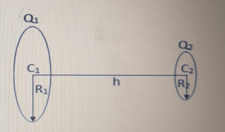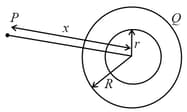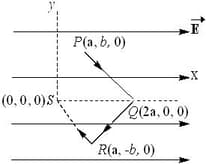Electric Potential
Electric Potential: Overview
This topic covers concepts, such as Electric Potential, Potential Difference, and Potential Difference between Two Points in Uniform Electric Field.
Important Questions on Electric Potential
Figure shows two co-axial rings of radius and having charges and . Their centres are separated by distance . Find potential at the midpoint of line segment joining of centres of the two rings.

A unit charge is moved in a circular path of radius having a point charge at the centre. The work done in one complete rotation is
Assertion: Electrons move from a region of higher potential to a region of lower potential.
Reason: An electron has less potential energy at a point where potential is higher and vice-versa.
Assertion: Electrons move away from a region of lower potential to a region of higher potential.
Reason: Since an electron has negative charge.
Assertion: The potential of a conductor depend upon the charge given to it.
Reason: Potential depend on charge as well as shape and size of conductor also.
Assertion: When two charge particles are moved away from each other, then their electric potential energy must decrease.
Reason: For two point charges and at separation , electric potential energy is .
A long, hollow conducting cylinder is kept coaxially inside another long, hollow conducting cylinder of larger radius. Both the cylinders are initially electrically neutral.
of work has to be done against an existing electric field to take a charge of from to . Then the potential difference is
Two insulated charged spheres of radii and respectively, and having an equal charge , are connected by a copper wire. Then they are separated. Which of the following is correct?
When two uncharged metal balls, each of radius , collide, two electrons are transferred between them. The potential difference between them would be
When a body is connected to the earth, then electrons from the earth flow into the body. It means that the body is
The electric potential at point is and at is . The work done by an external force, in moving an electron slowly from to , is
Eight charges, each of the magnitude , are placed at the vertices of a cube, placed in vacuum. Electric potential at the centre of the cube, due to this system of charges, is
( is permittivity of vacuum and is the length of each side of the cube).
An electric charge is placed at the origin of an co-ordinate system. Two points, and , are situated at and , respectively. The potential difference between the points and will be
On moving a charge of from point , where the potential is , to point , where the potential is , the work done is
An electric field is spread uniformly in -axis. Consider a point as origin point. The co-ordinates of point are equal to . The co-ordinates of point are . At points , and , electric potentials are and respectively. From the following options, which is correct?
The electric potential at point is and is . The work done by an external force in moving electron slowly from to is -
Two concentric spheres (hollow) are shown in diagram. What charge should be given to the smaller sphere so that potential at point outside the sphere is zero ? :

On moving a charge of from a point , where potential is to a point , where potential is , the work done is
A point charge moves from point to point along the path in a uniform electric field pointing parallel to the positive direction of the axis, figure. The coordinates of the points and are , , and , respectively. The work done by the field in the above process is given by the expression

